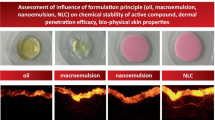Abstract
Terpenes are widely used in the topical dermal preparations, cosmetics and toiletries and also in the experimental dermopharmacy, as penetration enhancers. Terpenes do not need to penetrate into viable skin tissue and this event is not even desired. The aim of this study was to investigate skin absorption and elimination kinetics of two terpenes, namely linalool and terpinen-4-ol, incorporated in three different dermatological vehicles: oily solution, hydrogel and o/w emulsion. The preparations were applied onto the human skin in vitro, and after 1–4 h the content of terpenes in the stratum corneum layers and in the epidermis/dermis was determined using GC. Similarly, the amounts of terpenes in the skin were analysed during 4 h elimination process following 1 h absorption. The highest skin absorption was observed when terpenes were applied in hydrogel — their total content in the skin after 4 h was 385 and 705 μg/cm2 for linalool and terpinen-4-ol, respectively. After 1 h of the elimination process about 10–20% drop of the total content of both terpenes in the skin was noted for all formulations. The skin penetration of both terpenes from the vehicles is increasing in the following order: emulsion < oily solution < hydrogel, while the elimination phase is relatively slower for terpenes applied in hydrogel.



Similar content being viewed by others
References
Bach M, Lippold BC (1998) Percutaneous penetration enhancement and its quantification. Eur J Pharm Biopharm 46:1–13
Brain KR, Walters KA, Watkinson AC (1998) Investigation of permeation in vitro. In: Roberts MS, Walters KA (eds) Dermal absorption and toxicity assessment. Marcel Dekker, New York, pp 161–187
Bronaugh RL (1991) In vitro percutaneous absorption: principles, fundamentals, and applications. CRC Press, Boca Raton
Cal K, Janicki S, Sznitowska M (2001) In vitro studies on penetration of terpenes from matrix-type transdermal systems through human skin. Int J Pharm 224:81–88
Cal K, Sznitowska M (2003) Cutaneous absorption and elimination of three acyclic terpenes—in vitro studies. J Control Release 93:369–376
Cal K, Kupiec K, Sznitowska M (2005) Effect of physicochemical properties of cyclic terpenes on their ex vivo skin absorption and elimination kinetics. J Dermatol Sci (in press). DOI 10.1016/j.jdermsci.2005.09.003
Jacobi U, Meykadeh N, Sterry W, Lademann J (2003) Effect of the vehicle on the stratum corneum removed by tape stripping. J Dtsch Dermatol Gesell 1:884–889
Jacobi U, Bartoll J, Sterry W, Lademan J (2005) Orally administered ethanol: transepidermal pathways and effect on the human skin barrier. Arch Dermatol Res 296:332–338
Jacobi U. Taube H, Schaefer UF, Sterry W, Lademann J (2005) Comparison of four different in vitro systems to study the reservoir capacity of the stratum corneum. J Control Release 103:61–71
Kemppainen BW, Reifenrath WG (1990) Methods for skin absorption. CRC Press, Boca Raton
Lindemann U, Weigmann HJ, Schaefer H, Sterry W, Lademann J (2003) Evaluation of the pseudo-absorption method to quantify human stratum corneum removed by tape stripping using protein absorption. Skin Pharmacol Appl Skin Physiol 16:228–236
Loth H (1991) Vehicular influence on transdermal drug penetration. Int J Pharm 68:1–10
Pelchrzim R, Weigmann HJ, Schaefer H, Hagemeister T, Linscheid M, Shah VP, Sterry W, Lademann J (2004) Determination of the formation of the stratum corneum reservoir for two different corticosteroid formulations using tape stripping combined with UV/VIS spectroscopy. J Dtsch Dermatol Gesell 2:914–919
Rastogi SC, Johansen JD, Menne T (1996) Natural ingredients based cosmetics. Content of selected fragrance sensitizers. Contact Dermat 34:423–426
Schaefer H, Redelmeier TE (1996) Skin barrier: principles of percutaneous absorption. Karger, Basel
Schempp CM, Schopf E, Simon JC (2002) Durch Pflanzen ausgeloste toxische und allergische Dermatitis (Phytodermatitis). Hautarzt 53:93–97
Smith E, Surber C (1999) The absolute fundamentals of transdermal permeation (drug delivery for dummies). In: Gabard B, Elsner P, Surber C, Treffel P (eds) Dermatopharmacology of topical preparations. Springer, Berlin Heidelberg New York, pp 23–35
Wagner H, Kostka KH, Adelhardt W, Schaefer UF (2004) Effects of various vehicles on the penetration of flufenamic acid into human skin. Eur J Pharm Biopharm 58:121–129
Williams AC, Barry BW (1991) Terpenes and the lipid–protein-partitioning theory of skin penetration enhancement. Pharm Res 8:17–24
Williams AC, Barry BW (2004) Penetration enhancers. Adv Drug Deliv Rev 56:603–618
Yener G, Gonullu U, Uner M, Degim T, Araman A (2003) Effect of vehicles and penetration enhancers on the in vitro percutaneous absorption of celecoxib through human skin. Pharmazie 58:330–333
Acknowledgements
This study was supported by grant No. 2 P05F 003 26 from State Committee for Scientific Research, Poland.
Author information
Authors and Affiliations
Corresponding author
Rights and permissions
About this article
Cite this article
Cal, K. How does the type of vehicle influence the in vitro skin absorption and elimination kinetics of terpenes?. Arch Dermatol Res 297, 311–315 (2006). https://doi.org/10.1007/s00403-005-0622-4
Received:
Revised:
Accepted:
Published:
Issue Date:
DOI: https://doi.org/10.1007/s00403-005-0622-4




